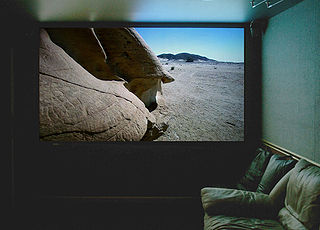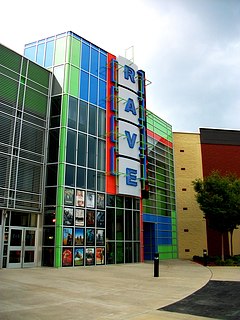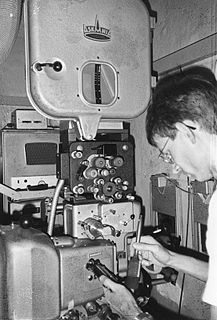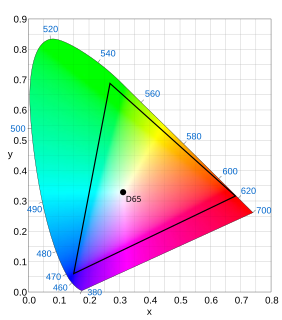Related Research Articles
Digital cinema refers to the use of digital technology to distribute or project motion pictures as opposed to the historical use of reels of motion picture film, such as 35 mm film. Whereas film reels have to be shipped to movie theaters, a digital movie can be distributed to cinemas in a number of ways: over the Internet or dedicated satellite links, or by sending hard drives or optical discs such as Blu-ray discs. Digital movies are projected using a digital video projector instead of a film projector. Digital cinema is distinct from high-definition television and does not necessarily use traditional television or other traditional high-definition video standards, aspect ratios, or frame rates. In digital cinema, resolutions are represented by the horizontal pixel count, usually 2K or 4K. As digital-cinema technology improved in the early 2010s, most theaters across the world converted to digital video projection.
The Motion Picture Patents Company, founded in December 1908 and terminated seven years later in 1915 after conflicts within the industry, was a trust of all the major US film companies and local foreign-branches, the leading film distributor and the biggest supplier of raw film stock, Eastman Kodak. The MPPC ended the domination of foreign films on US screens, standardized the manner in which films were distributed and exhibited within the US, and improved the quality of US motion pictures by internal competition. But it also discouraged its members' entry into feature film production, and the use of outside financing, both to its members' eventual detriment.

35 mm film is a film gauge used in filmmaking, and the film standard. In motion pictures that record on film, 35 mm is the most commonly used gauge. The name of the gauge is not a direct measurement, and refers to the nominal width of the 35 mm format photographic film, which consists of strips 1.377 ± 0.001 inches (34.976 ± 0.025 mm) wide. The standard image exposure length on 35 mm for movies is four perforations per frame along both edges, which results in 16 frames per foot of film.

A video projector is an image projector that receives a video signal and projects the corresponding image on a projection screen using a lens system. Video projectors use a very bright ultra high pressure mercury lamp, Xenon arc lamp, LED or solid state blue, RB, RGB or remote fiber optic RGB lasers to provide the illumination required to project the image, and most modern ones can correct any curves, blurriness, and other inconsistencies through manual settings. If a blue laser is used, a phosphor wheel is used to turn blue light into white light, which is also the case with white LEDs. A wheel is used in order to prolong the lifespan of the phosphor, as it is degraded by the heat generated by the laser diode. Remote fiber optic RGB laser racks can be placed far away from the projector, and several racks can be housed in a single, central room. Each projector can use up to 2 racks, and several monochrome lasers are mounted on each rack, the light of which is mixed and transmitted to the projector booth using optical fibers. Projectors using RB lasers use a blue laser with a phosphor wheel in conjuntion with a conventional solid state red laser.

Digital Light Processing (DLP) is a set of chipsets based on optical micro-electro-mechanical technology that uses a digital micromirror device. It was originally developed in 1987 by Larry Hornbeck of Texas Instruments. While the DLP imaging device was invented by Texas Instruments, the first DLP-based projector was introduced by Digital Projection Ltd in 1997. Digital Projection and Texas Instruments were both awarded Emmy Awards in 1998 for the DLP projector technology. DLP is used in a variety of display applications from traditional static displays to interactive displays and also non-traditional embedded applications including medical, security, and industrial uses.

A movie projector is an opto-mechanical device for displaying motion picture film by projecting it onto a screen. Most of the optical and mechanical elements, except for the illumination and sound devices, are present in movie cameras.

Rave Cinemas, formerly known as "Rave Motion Pictures", is a movie theater brand founded in 1999 and owned by Cinemark Theatres. It previously was headed by Thomas W. Stephenson, Jr., former CEO of Hollywood Theaters, and Rolando B. Rodriguez, former Vice President and Regional General Manager for Walmart in Illinois and northern Indiana. The chain was headquartered in Dallas, Texas until it was acquired by Plano-based Cinemark Theatres.

A projectionist is a person who operates a movie projector. In the strict sense of the term this means any film projector and therefore could include someone who operates the projector in a show. In common usage the term is generally understood to describe a paid employee of a movie theater. Projectionists are also known as "operators".
A film distributor is responsible for the marketing of a film. The distribution company is usually different from the production company. Distribution deals are an important part of financing a film.

Digital cinematography is the process of capturing (recording) a motion picture using digital image sensors rather than through film stock. As digital technology has improved in recent years, this practice has become dominant. Since the mid-2010s, most movies across the world are captured as well as distributed digitally.
Digital Cinema Initiatives, LLC (DCI) is a consortium of major motion picture studios, formed to establish specifications for a common systems architecture for digital cinema systems.
CinemaNext was named XDC from its creation in 2004 by Laurent Minguet to 2012 when it changed its name to dcinex until it was bought by Ymagis Group in 2014 and renamed CinemaNext. It is a cinema exhibition services company based in Liège but it also has offices in 26 other countries including France, Spain and Germany. The principal activities of CinemaNext are the installation and maintenance of projection equipment, sound systems and outfitting for cinemas. They also offer consulting to cinemas about financing and managing their refurbishment projects.

Premiere Cinemas, officially known as Premiere Cinema Corporation., headquartered in Big Spring, Texas, is a privately held motion picture exhibitor. It is among the largest independently owned motion picture exhibitors in the U.S. and is ranked by Box Office magazine and the National Association of Theatre Owners Encyclopedia of Exhibition among the top 12 circuits in the U.S. Premiere is owned by Gary Moore, who bought his first theater in 1985 and incorporated Premiere in 1993.
A Digital Cinema Package (DCP) is a collection of digital files used to store and convey digital cinema (DC) audio, image, and data streams.

Doremi Laboratories, Inc., often shortened to Doremi Labs, was a developer and manufacturer of digital servers and format converters for the digital cinema, broadcast, post production and professional A/V markets. It was established in 1985 in Burbank, California, United States, and was absorbed into Dolby Laboratories in a 2014 acquisition.
Event cinema sometimes called alternative content cinema or livecasts refers to the use of cinema theaters to display a varied range of live and recorded entertainment excluding traditional films, such as sport, opera, musicals, ballet, music, one-off TV specials, current affairs, comedy and religious services.

Cinedigm Corp. is an American entertainment company headquartered in Los Angeles, California. Cinedigm's businesses encompass digital cinema, software, content marketing, and distribution.

Dolby Cinema is a premium cinema created by Dolby Laboratories that combines Dolby proprietary technologies such as Dolby Vision and Dolby Atmos, as well as other signature entrance and intrinsic design features. The technology competes with IMAX and other premium large formats such as Cinemark's XD and Regal's RPX.
A Media Block or Integrated Media Block is a component in a digital cinema projection system. Its purpose is to convert the Digital Cinema Package (DCP) content into data that ultimately produces picture and sound in a theater in compliance with DCI anti-piracy encryption requirements.

DCI-P3, or DCI/P3, is a common RGB color space for digital movie projection from the American film industry.
References
- ↑ LLC, MKPE Consulting. "Digital Cinema Business FAQs" . Retrieved 18 February 2017.
- ↑ Digital cinema#Technology demonstrations and system prototyping
- ↑ companyv. "Digital Cinema Initiatives (DCI) - DIGITAL CINEMA SYSTEM SPECIFICATION, VERSION 1.2" . Retrieved 18 February 2017.
- ↑ "NEW SONY PICTURES AGREEMENT WITH CHRISTIE/AIX SUPPORTS DIGITAL CINEMA TRANSITION (NASDAQ:CIDM)" . Retrieved 18 February 2017.
- ↑ "Home - Cinedigm" . Retrieved 18 February 2017.
http://www.davidbordwell.net/blog/2011/12/01/pandoras-digital-box-in-the-multiplex/